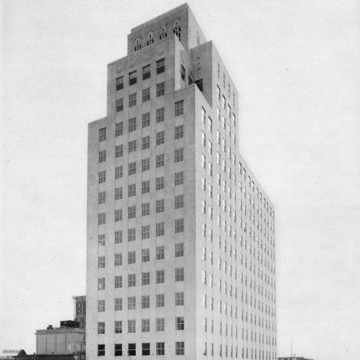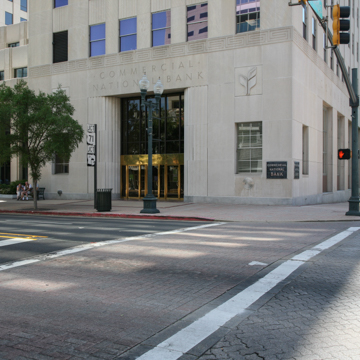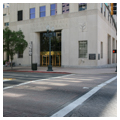Shreveport architect Samuel G. Wiener collaborated with the New York City firm of McKim, Mead and White in the design and construction of this austere Moderne skyscraper. Located on a prime corner site in the city’s downtown, the steel-framed building, clad in limestone, has a narrow front facing Texas Street and stretches back along Edwards Street. Several setbacks conclude the upper sections of the front portion of the seventeen-story building, while the rear section rises to thirteen stories. Wiener's preliminary sketch for the bank, in the archives of Louisiana State University, Shreveport, depicts a structure with a simpler outline, but the final design incorporated pronounced setbacks. Both the sketch and the completed structure place emphasis on the expression of height. To this end, piers between the windows rise without interruption to the building's summit. Fluting along the cornice, on the spandrels, beside the principal entrance, and between the first-story windows along the building’s side further accentuates verticality. The lobby is enriched with murals depicting the area's history, which were painted on Belgian linen by Texas artist James Buchanan “Buck” Winn Jr. Upon its completion, photographs of the bank were published in contemporary architecture journals in advertisements promoting the building's use of cellular floors (known as Q floors) that provided six-inch-deep spaces between floors for easy access to electrical wiring. The building, the tallest in Shreveport at the time it was constructed, was soon surpassed in height as this city, a center of the oil industry, continued to boom in the years following World War II.
You are here
Old Commercial National Bank
If SAH Archipedia has been useful to you, please consider supporting it.
SAH Archipedia tells the story of the United States through its buildings, landscapes, and cities. This freely available resource empowers the public with authoritative knowledge that deepens their understanding and appreciation of the built environment. But the Society of Architectural Historians, which created SAH Archipedia with University of Virginia Press, needs your support to maintain the high-caliber research, writing, photography, cartography, editing, design, and programming that make SAH Archipedia a trusted online resource available to all who value the history of place, heritage tourism, and learning.























